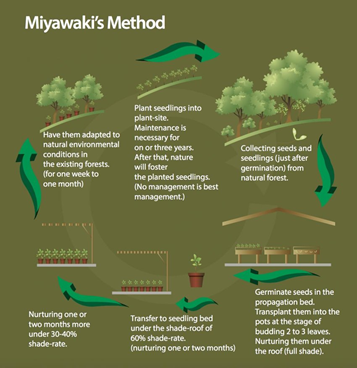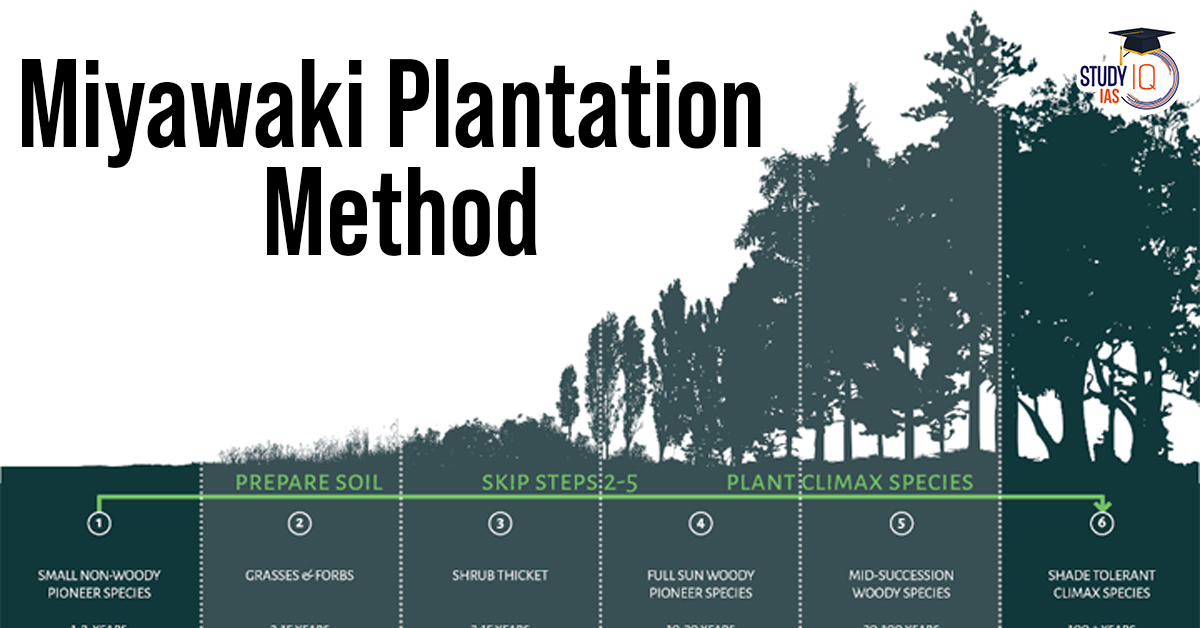Table of Contents
Context: During the recently concluded Maha Kumbh in Prayagraj, Uttar Pradesh government implemented the Miyawaki Method for afforestation & to create “oxygen banks” and increase green cover.
About Miyawaki Method of Plantation
- Miyawaki Method is a technique for creating forests quickly using native trees on degraded land. It is based on principles of natural reforestation and is effective in urban areas.
- Developed by: Japanese botanist Akira Miyawaki in the 1970s, it is also called the pot plantation method.
- It involves planting native species of trees and shrubs very close together, accelerating their growth.
- Plants grow up to 10 times faster with this technique compared to traditional methods.
- It helps create self-sustaining forests in a short period by mimicking natural ecosystems.
- The method is particularly effective in urban areas where space is limited and is used to combat deforestation, climate change and urban pollution.

Benefits
- Fast-growing: The trees grow quickly, which helps create forest cover quickly
- High biodiversity: Miyawaki forests have higher biodiversity than neighbouring woodlands.
- Carbon capture: The trees capture more carbon.
- Climate remediation: The method can help remedy soil, air, water, and climate issues.
Key Features of Miyawaki Method
Focus on Native Species
- Only indigenous tree species are planted to ensure high survival rates.
- These trees require less water, fertilizers and maintenance after the initial phase.
High-Density Plantation
- Plants are placed 3-5 saplings per square meter, creating dense green cover.
- The close spacing forces trees to compete for sunlight, resulting in rapid vertical growth.
Fast Growth & Self-Sustaining Forests
- Trees grow 10 times faster than in traditional afforestation methods.
- A fully developed forest can be achieved in 20-30 years instead of 100-200 years.
- After 3 years, forests become self-sustaining, requiring minimal human intervention.
Multi-Layered Forest Structure
It mimics a natural forest with four layers of vegetation:
- Shrubs (small bushes and plants)
- Sub-trees (medium-sized trees)
- Canopy trees (tall trees forming a dense upper cover)
- Emergent trees (the tallest trees extending beyond the canopy).
Applications of the Miyawaki Method
- Urban forest projects
- Restoration of degraded lands
- Combatting desertification
- Beautification of residential and industrial spaces
| UPSC PYQ |
| Q. The “Miyawaki method” is well known for the: (2022)
(a) Promotion of commercial farming in arid and semi-arid areas (b) Development of gardens using genetically modified flora (c) Creation of mini forests in urban areas (d) Harvesting wind energy on coastal areas and on sea surfaces Answer: C |


 List of National Parks in India 2025, Ch...
List of National Parks in India 2025, Ch...
 Bonnet Macaques: Habitat, Features, Beha...
Bonnet Macaques: Habitat, Features, Beha...
 Periyar Tiger Reserve, Map, Flora, Fauna...
Periyar Tiger Reserve, Map, Flora, Fauna...

























